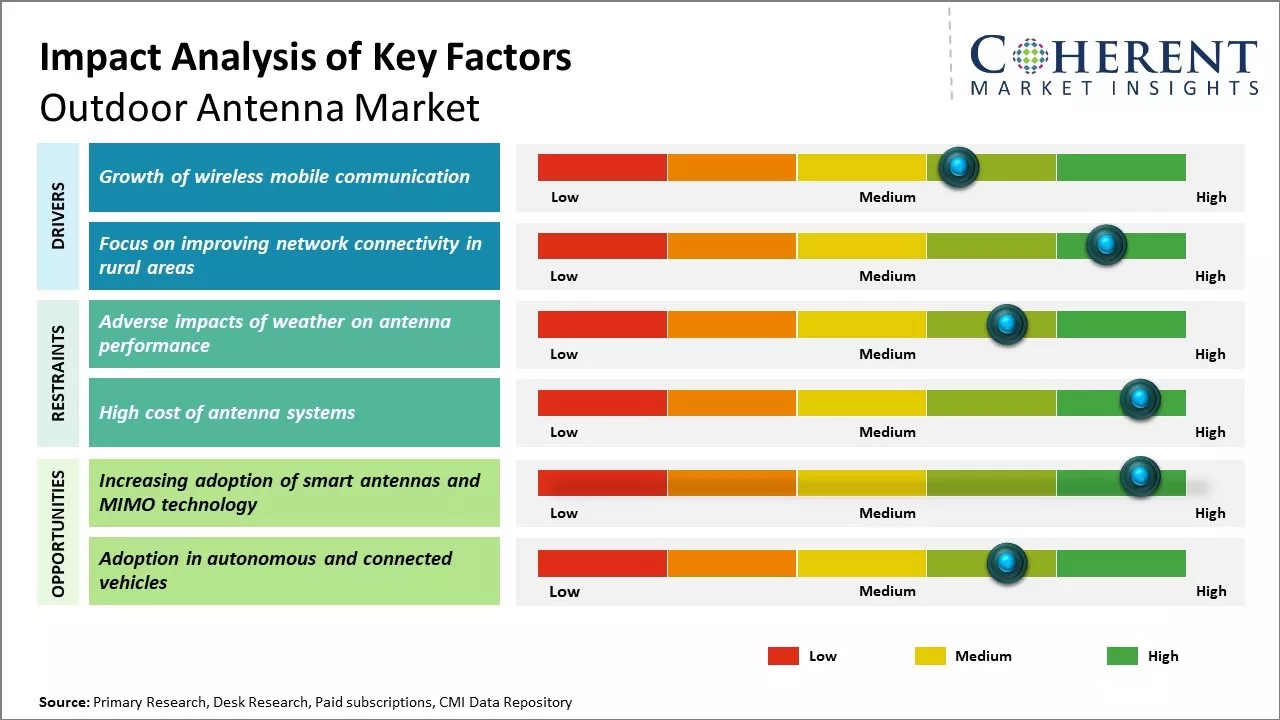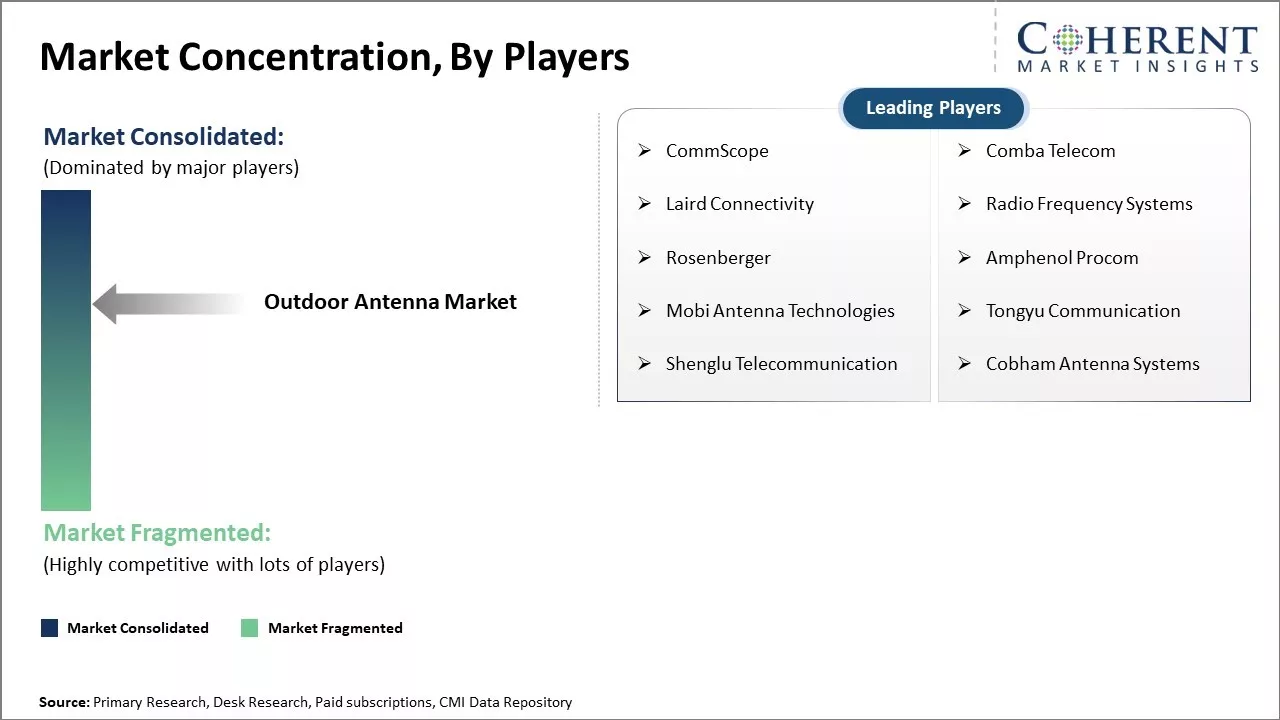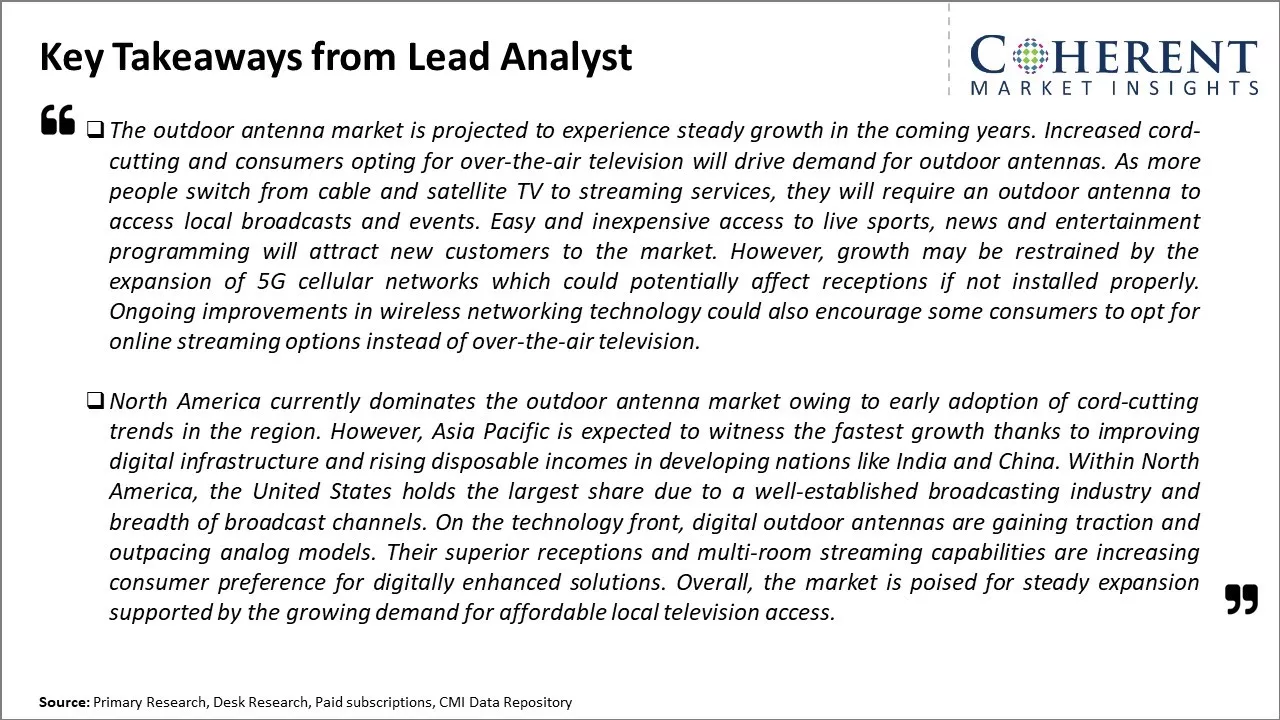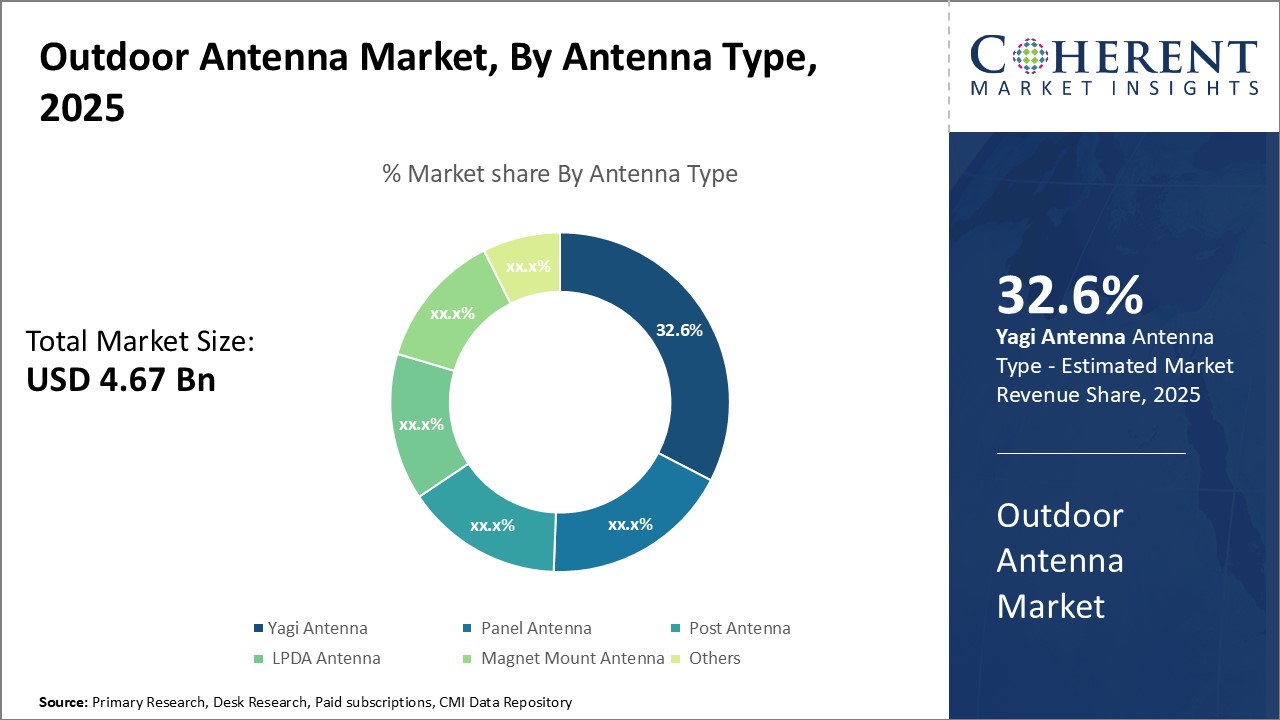The outdoor antenna market is estimated to be valued at USD 4.67 Bn in 2025 and is expected to reach USD 9.52 Bn by 2032, growing at a compound annual growth rate (CAGR) of 10.7% from 2025 to 2032.
The outdoor antenna market is witnessing high growth driven by the increasing demand for seamless connectivity and availability of affordable internet services across various regions.

Discover market dynamics shaping the industry: Download Free Sample
Outdoor antennas are widely used by telecom operators for cellular, broadcast, and wireless services to provide connectivity in rural and remote areas. Also, the rapid rollout of 4G and 5G networks around the world has increased the demand for outdoor antennas significantly. Rising M2M/IoT communications and autonomous vehicles further open lucrative opportunities for market players over the coming years. However, the growth of wireless fiber and evolving connectivity technologies may limit the demand to some extent. Overall, the outdoor antenna market is expected to flourish during the forecast period supported by the growing need for ubiquitous connectivity solutions globally.
Growth of wireless mobile communication
The advent of wireless mobile communication about two decades ago changed the way people communicate. It gave users the freedom and flexibility to connect from anywhere at any time. As wireless networks developed, delivering faster internet and wider coverage, people's reliance, and usage of mobile devices exploded. Today, mobile devices have become an integral part of the daily lives whether for personal or professional use. This growing dependence and usage has propelled the need for advanced cellular infrastructure, especially outdoor wireless connectivity solutions.
As more people subscribe to wireless networks for voice and data services, operators are compelled to enhance and expand their network coverage through outdoor wireless solutions to support the increasing mobile traffic and ensure quality of service. They are deploying various outdoor wireless technologies including macro cells, small cells, and distributed antenna systems (DAS) to supplement their coverage in urban, suburban and rural areas. For example, according to the statistics of the International Telecommunication Union, the number of active mobile broadband subscriptions worldwide surpassed 5 billion in 2021, registering a growth of over 50% in the last 5 years. This rapid uptake in mobile subscriptions demonstrates people's growing reliance on mobile internet, putting pressure on operators to enhance their wireless connectivity infrastructure.
The deployment of 5G networks is expected to further drive the demand for outdoor wireless solutions in the coming years. 5G, with its ability to support new applications involving IoT, AI, and more connected devices, will require unprecedented network capacity. This will necessitate mobile operators to install and upgrade various outdoor wireless solutions, including macro towers equipped with MIMO radios, small cells, and DAS, to meet the new network demands of 5G.

Get actionable strategies to beat competition: Download Free Sample
Focus on improving network connectivity in rural areasNetwork connectivity in rural areas has been improving significantly, which is one of the major factors driving the growth of the global outdoor antenna market. Many nations around the world have realized the importance of providing broadband internet to all citizens, including those living in remote, isolated rural regions. This helps in digital inclusion and bridges the urban-rural divide. Governments are heavily investing in rural broadband projects through schemes like broadband for all. For example, the Indian government announced a US$ 725 Million rural broadband project in 2020 to connect vulnerable villages through WiFi hotspots. It aims to setup over six lakh WiFi hotspots across the country by 2023. Similarly, the Department of Agriculture, Forestry, and Fisheries of South Africa allocated 50 million rand in 2021 to improve the ICT infrastructure and expand internet connectivity across rural communities. Such initiatives have increased the demand for reliable outdoor antennas that can establish wireless signals in areas with rough terrain and geographical obstacles.
As the internet and connectivity become basic necessities, the focus on enhancing rural broadband will keep rising in the coming years too. This will directly promote the sales of outdoor television and radio antennas, satellite dishes, WiFi antennas, etc. that help subscribers stream content, make video calls, and access services like telemedicine and e-education from farms and small towns. Antenna manufacturers are leveraging the latest technologies, such as self-optimizing antennas, smart antennas, and fixed wireless access solutions, to improve coverage and throughput for subscribers in sparsely populated areas.

To learn more about this report, Download Free Sample
Market Challenge: Adverse impacts of weather on antenna performanceThe weather conditions play a very important role in determining the performance of outdoor antennas that are used for telecommunication, broadcasting, and other purposes. Adverse weather such as heavy rain, snow, hailstorms, dust storms, and high winds can severely degrade the performance of outdoor antennas. The main issues caused by adverse weather include signal attenuation, interference, impedance mismatching, and physical damage to antennas. Signal attenuation due to precipitation is one of the major problems faced by outdoor antennas during rainy and snowy conditions. Heavy rain and hail can absorb and scatter radio signals, significantly reducing their strength and range. High winds in storms and hurricanes can potentially damage the physical structure of pole mounted outdoor antennas or cause them to fall. This leads to disruptions in services and increased maintenance costs.
According to the World Meteorological Organization, the frequency and intensity of extreme weather events have increased from 2020 to 2022 across many parts of the world. For example, as per the data from the National Oceanic and Atmospheric Administration (NOAA) of the U.S., the number of billion-dollar weather and climate disasters in the U.S. has risen from an average of five events per year during the 1990s to an average of 15 events per year from 2020 to 2022. This rising trend of extreme weather conditions poses serious challenges for the reliable and stable performance of outdoor antennas used by broadcasters, mobile network operators, and other telecom players. The outages and interruptions caused increases the total cost of ownership of outdoor antenna infrastructure. This major restraint acts as a deterrent for investments into outdoor antennas limiting the growth of the overall market. Suitable technological and engineering solutions need to be developed to make outdoor antennas more resilient to handle adverse weather conditions better.
Market Opportunity: Increasing adoption of smart antennas and MIMO technology
Smart antennas and MIMO technology allow for more efficient use of available spectrum by focusing radio signals to desired locations and nulling interfering signals. This enables higher throughput, lower interference, and increased coverage without additional infrastructure or spectrum. For example, according to the International Telecommunication Union (ITU), MIMO technology helped increase network capacity 2-3 times compared to traditional antenna systems in test deployments by mobile operators in Europe and Asia Pacific in 2021-2022.
According to the Broadband Commission, mobile data traffic in North America is projected to grow at a CAGR of 46% from 2020 to 2023. Similarly, a World Economic Forum (WEF) report found that in Southeast Asia, mobile internet penetration reached 75% by end of 2022, but data consumption per user is set to grow four times by 2025.

Discover high revenue pocket segments and roadmap to it: Download Free Sample
Insights, By Antenna Type- Advantages of Directivity Drive the Yagi Antenna Segment GrowthIn terms of antenna type, yagi antenna is expected to contribute the highest share of 32.6% in 2025, owning to its advantages related to directivity. Yagi antennas are directional antennas that are designed to effectively transmit or receive radio waves in one direction, making them well suited for point-to-point communication links. This high directivity allows yagi antennas to focus transmission and reception in a particular direction, thereby avoiding interference from signals coming from other directions. Their directivity helps enhance gain and power without requiring too many elements, making them an efficient and economical choice compared to other directional antennas like parabolic dishes.
Directivity enables yagi antennas to operate over longer communication distances compared to omni-directional alternatives like dipole antennas. Their directional nature strengthens signal strength in the intended direction while reducing interference from unwanted directions. This improves reliability and quality of wireless links for outdoor applications requiring connectivity over larger areas. Yagi antennas are commonly used for television reception and ham radio operations where connecting two distant points is essential. Their precise directional control allows optimal line-of-sight communication without facing issues like dead spots experienced with omni-directional antennas.
Insights, By Antenna Gain- Ideal Gain for Medium Range Connectivity Boosts the 4 dB - 8 dB Segment Share
In terms of antenna gain, the 4 dB - 8 dB segment is expected to contribute the highest share of 46.68% in 2025, as it offers an ideal balance of gain and practicality for medium range outdoor applications. Antenna gain is a measure of its power amplification ability in a certain direction. Higher gain translates to longer communication distances but comes with design complexity, cost and size trade-offs. In contrast, antennas with gain less than 4 dB have limited range but are more compact and affordable.
The 4 dB - 8 dB gain range meets requirements of multiple outdoor applications that require connecting points within line-of-sight up to a few miles apart. It empowers wireless bridges, backhaul systems and surveillance cameras among others to effectively transmit data and video signals over distances not possible through lower gain antennas. Such medium connectivity needs exist abundantly across sectors like industrial facilities, educational campuses, transportation hubs and more.
Moreover, antennas within this gain tier strike an optimal balance between size and performance. Despite higher gain than less than 4 dB antennas, their physical dimensions and wind loading characteristics make them suitable for mounting on poles, walls, towers and other outdoor structures. This flexibility of installation widens the eligible use cases for 4 dB - 8 dB antennas compared to higher gain alternatives facing space and weight restrictions.
Insights, By End-use Industry - Critical Communication Needs Fuels the IT & Telecom's Dominance in End-use Industry
In terms of end-use industry, the IT & Telecommunication segment is expected to contribute the highest share of 58.21% in 2025, owing to burgeoning outdoor infrastructure needs of this industry. IT and telecom organizations rely extensively on outdoor wireless and networking equipment for delivering services and connecting remote assets. As data traffic and number of connected devices continue rising exponentially, their infrastructure expansion remains relentless to cope with escalating bandwidth requirements.
Maintaining uptime of networks spanning wide outdoor areas including cellular towers, rooftop WiFi hotspots, IoT sensor nodes, etc. requires high quality transmission of voice and data signals over long distances under varied environmental conditions. This raises the imperative of outdoor antenna solutions that can withstand weather vagaries while ensuring seamless connectivity. As performance, reliability and coverage are vital for uninterrupted telecom operations, this industry spends substantially on antennas featuring ruggedized housing, low maintenance and improved wireless coverage. Additionally, deployment of upcoming technologies like 5G, private LTE/5G networks and smart city IoT drives fresh antenna installation and upgradation projects across multiple sites. Transition to high frequency mmWave spectrum further boosts demand for highly directional antennas in telecom outward infrastructure. Monitoring and upkeep of rapidly expanding transmission networks also stimulates continuous antenna procurement.

Need a Different Region or Segment? Download Free Sample
Asia Pacific is expected to establish itself as the dominant region in the outdoor antenna market with the highest market share of 41.0% in 2025. Rapid urbanization and rising disposable incomes have enabled more people in densely populated countries like India and China to access television and wireless services on various connected devices. While cable and satellite TV penetration is improving, broadcasts through digital terrestrial signals have also increased coverage in the past five years. As reception quality remains an issue in certain locations, affordable outdoor antennas have gained popularity here.
Furthermore, favorable government initiatives aimed at connecting remote populations have augmented demand. Local manufacturers have also entered the market, offered low-cost customized solutions while leveraged Asia's electronics manufacturing capabilities. Brand recognition of international players is gradually increasing as well through innovative branding and effective distribution. Outdoor antennas made specifically for the tropical climate have found many takers. Imports and exports of related accessories have strengthened ties within the Asia Pacific and Middle Eastern markets too.
North America region is expected to emerge as the fastest growing market for outdoor antennas with the highest CAGR of 15.28% in 2025. The region is home to several major players that have been operating in this market for decades. They have sizable manufacturing capabilities and distribution networks within the region as well as globally. Moreover, consumer spending on premium television and wireless services has traditionally been higher in the U.S. and Canada compared to other markets. This has translated into strong demand for good quality outdoor antennas to access various programming options and internet connectivity in remote areas.
Outdoor Antenna Market Report Coverage
| Report Coverage | Details | ||
|---|---|---|---|
| Base Year: | 2024 | Market Size in 2025: | USD 4.67 Bn |
| Historical Data for: | 2020 To 2024 | Forecast Period: | 2025 To 2032 |
| Forecast Period 2025 to 2032 CAGR: | 10.7% | 2032 Value Projection: | USD 9.52 Bn |
| Geographies covered: |
|
||
| Segments covered: |
|
||
| Companies covered: |
CommScope, Comba Telecom, Laird Connectivity, Radio Frequency Systems, Rosenberger, Amphenol Procom, Mobi Antenna Technologies, Tongyu Communication, Shenglu Telecommunication, and Cobham Antenna Systems |
||
| Growth Drivers: |
|
||
| Restraints & Challenges: |
|
||
Uncover macros and micros vetted on 75+ parameters: Get instant access to report
*Definition: The outdoor antenna market consists of various types of antennas that are installed outdoors to receive TV signals, radio signals, and wireless data signals. This includes TV antennas, FM antennas, HDTV antennas, digital antennas, amplified antennas, and outdoor WiFi antennas that provide the reception of broadcasts without the need for cable or satellite dishes. Outdoor antennas allow users to access free broadcast content directly from signals in the air.
Share
Share
About Author
As an accomplished Senior Consultant with 7+ years of experience, Pooja Tayade has a proven track record in devising and implementing data and strategy consulting across various industries. She specializes in market research, competitive analysis, primary insights, and market estimation. She excels in strategic advisory, delivering data-driven insights to help clients navigate market complexities, optimize entry strategies, and achieve sustainable growth.
Missing comfort of reading report in your local language? Find your preferred language :
Transform your Strategy with Exclusive Trending Reports :
Frequently Asked Questions
Joining thousands of companies around the world committed to making the Excellent Business Solutions.
View All Our Clients